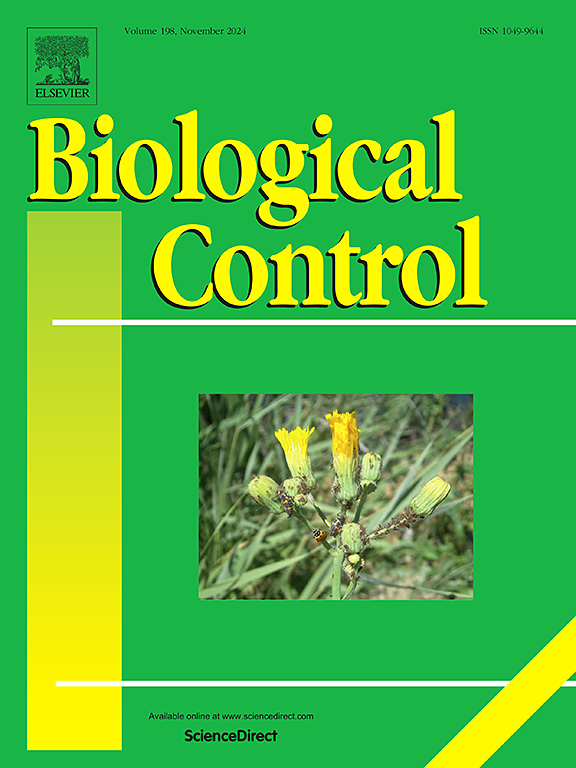拟除虫菊酯抗性对昆虫病原线虫防治斑点直纹蛾效果的影响
IF 3.7
2区 农林科学
Q2 BIOTECHNOLOGY & APPLIED MICROBIOLOGY
引用次数: 0
摘要
昆虫病原线虫能有效防治北美东部高尔夫球场草坪草的主要害虫——蓝草象鼻虫(Listronotus maculicollis)幼虫。这种线虫可能对控制具有杀虫剂抗性的象鼻虫种群特别有用,因为耐药性是这种害虫普遍存在的问题。然而,似乎主要负责象鼻虫抗性的耐药机制,增强的酶解毒,可能有可能使线虫的共生细菌产生的化合物失活,这些化合物在感染过程中起重要作用。我们比较了几种线虫在不同杀虫剂抗性种群中对象鼻虫幼虫的管理效果。根据拟除虫菊酯类杀虫剂联苯菊酯的抗性比(RR50)确定象鼻虫种群的抗性水平。在温室试验中,已经观察到在中等抗性水平(RR50 55-76)下线虫的药效降低了20-32%,特别是feltiae Steinernema和S. carpocapsae。但在田间试验中,仅对高抗性象甲(RR50 343)的防效降低,对稻角象甲的防效降低16-20%。对杀虫剂的抗性不影响其药效,但普遍低于稻瘟病菌的药效。由于大多数蓝草象鼻虫种群要么不受抗性影响,要么具有不降低线虫药效的抗性水平,因此昆虫病原线虫仍然是每年管理蓝草象鼻虫和延缓杀虫剂抗性发展的有用工具。本文章由计算机程序翻译,如有差异,请以英文原文为准。

Effect of pyrethroid resistance on the efficacy of entomopathogenic nematodes for the control of Listronotus maculicollis (Coleoptera: Curculionidae)
Entomopathogenic nematodes can provide effective control of annual bluegrass weevil, Listronotus maculicollis, larvae, a major golf course turfgrass pest in eastern North America. The nematodes could be particularly useful for the control of insecticide-resistant weevil populations as resistance is a wide-spread problem with this pest. However, the resistance mechanism that appears to be primarily responsible for resistance in the weevil, enhanced enzymatic detoxification, may have the potential to deactivate compounds produced by the nematodes’ symbiotic bacteria that play important roles in the infection process. We compared the efficacy of several nematode species for the management of weevil larvae in populations with different insecticide resistance levels. The resistance level in weevil populations was defined based on the resistance ratio (RR50) of the pyrethroid insecticide bifenthrin. In greenhouse experiments, reduced nematode efficacy, particularly of the species Steinernema feltiae and S. carpocapsae, was already observed at moderate resistance levels (RR50 55–76) with reduction in efficacy of 20–32%. However, in field experiment efficacy was reduced only against a highly resistant weevil population (RR50 343) with a reduction of control by 16–20% for S. carpocapsae. Steinernema riobrave efficacy was not affected by insecticide resistance but was generally lower than S. carpocapsae efficacy. As most ABW populations are either not affected by resistance or have levels of resistance at which nematode efficacy is not reduced, entomopathogenic nematodes remain a useful tool for annual bluegrass weevil management and delaying insecticide resistance development.
求助全文
通过发布文献求助,成功后即可免费获取论文全文。
去求助
来源期刊

Biological Control
生物-昆虫学
CiteScore
7.40
自引率
7.10%
发文量
220
审稿时长
63 days
期刊介绍:
Biological control is an environmentally sound and effective means of reducing or mitigating pests and pest effects through the use of natural enemies. The aim of Biological Control is to promote this science and technology through publication of original research articles and reviews of research and theory. The journal devotes a section to reports on biotechnologies dealing with the elucidation and use of genes or gene products for the enhancement of biological control agents.
The journal encompasses biological control of viral, microbial, nematode, insect, mite, weed, and vertebrate pests in agriculture, aquatic, forest, natural resource, stored product, and urban environments. Biological control of arthropod pests of human and domestic animals is also included. Ecological, molecular, and biotechnological approaches to the understanding of biological control are welcome.
 求助内容:
求助内容: 应助结果提醒方式:
应助结果提醒方式:


